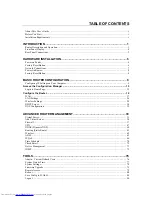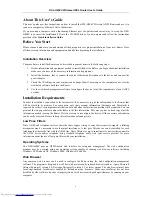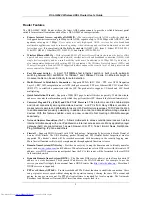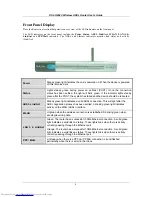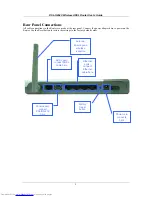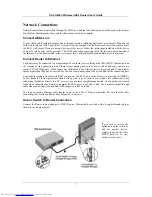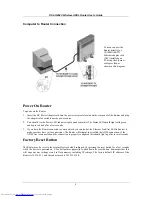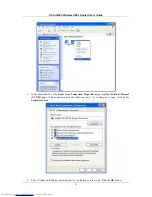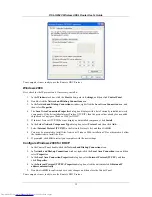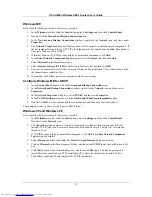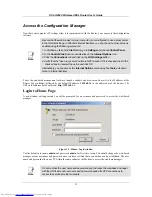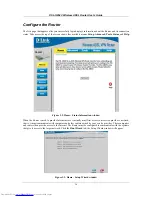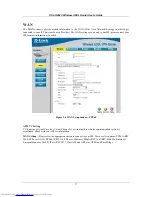
DSL-G804V Wireless ADSL Router User’s Guide
Router Features
The DSL-G804V ADSL Router utilizes the latest ADSL enhancements to provide a reliable Internet portal
suitable for most small to medium sized offices. DSL-G804V advantages include:
•
Express Internet Access – capable of ADSL2/2+ –
The router complies with ADSL worldwide standards.
It supports downstream rates up to 8Mbps with ADSL, capable of up to 12/24 Mbps with ADSL2/2+, and
upstream rates up to 1 Mbps.
Users enjoy not only high-speed ADSL services but also broadband
multimedia applications such as interactive gaming, video streaming and real-time audio much easier and
faster than ever.
It is compliant with Multi-Mode standard (ANSI T1.413, Issue 2; G.dmt (ITU G.992.1);
G.hs (ITU G994.1); G.dmt.bis (ITU G.992.3); G.dmt.bisplus (ITU G.992.5)).
•
Wireless Ethernet 802.11g
–
With integrated 802.11g Wireless Access Point in the router, the device offers
a quick and easy access among wired network, wireless network and broadband connection (ADSL) with
single device simplicity, and as a result, mobility to the users. In addition to 54 Mbps 802.11g data rate, it
also interoperates backward with existing 802.11b equipment. The Wireless Protected Access (WPA) and
Wireless Encryption Protocol (WEP) supported features enhance the security level of data protection and
access control via Wireless LAN.
•
Fast Ethernet Switch –
A 4-port 10/100Mbps fast Ethernet switch is built in with automatic
switching between MDI and MDI-X for 10Base-T and 100Base-TX ports. An Ethernet straight or
crossover cable can be used directly for auto detection.
•
Multi-Protocol to Establish A Connection –
Supports PPPoA (RFC 2364 - PPP over ATM Adaptation
Layer 5), RFC 1483 encapsulation over ATM (bridged or routed), PPP over Ethernet (RFC 2516) and IPoA
(RFC1577) to establish a connection with the ISP. The product also supports VC-based and LLC-based
multiplexing.
•
Quick Installation Wizard –
Supports a WEB GUI page to install this device quickly. With this wizard,
end users can enter the information easily which they get from their ISP, then surf the Internet immediately.
•
Universal Plug and Play (UPnP) and UPnP NAT Traversal –
This protocol is used to enable simple
and robust connectivity among stand-alone devices and PCs from many different vendors. It
makes network simple and affordable for users. UPnP architecture leverages TCP/IP and the Web
to enable seamless proximity networking in addition to control and data transfer among networked
devices. With this feature enabled, users can now connect to Net meeting or MSN Messenger
seamlessly.
•
Network Address Translation (NAT) –
Allows multi-users to access outside resources such as the
Internet simultaneously with one IP address/one Internet access account. Many application layer
gateway (ALG) are supported such as web browser, ICQ, FTP, Telnet, E-mail, News, Net2phone,
Ping, NetMeeting, IP phone and others.
•
Firewall –
Supports SOHO firewall with NAT technology. Automatically detects and blocks Denial of
Service (DoS) attacks. The URL blocking, packet filtering and SPI (Stateful Packet Inspection) are also
supported. The hacker’s attack will be recorded associated with timestamp in the security logging area.
More firewall functions will always be implemented through updated firmware releases.
•
Domain Name System (DNS) relay –
Provides an easy way to map the domain name (a friendly name for
users such as
www.yahoo.com
) and IP address. When local machine sets its DNS server with this router’s IP
address, every DNS conversion request packet from the PC to this router will be forwarded to the real DNS
in the outside network.
•
Dynamic Domain Name System (DDNS) –
The Dynamic DNS service allows you to alias a dynamic IP
address to a static hostname. This dynamic IP address is the WAN IP address. For example, to use the
service, you must first apply for an account from a DDNS service like
http://www.dyndns.org/
. More than 5
DDNS servers are supported.
•
PPP over Ethernet (PPPoE) –
Provides embedded PPPoE client function to establish a connection.
Users
can get greater access speed without changing the operation concept, sharing the same ISP account and
paying for one access account. No PPPoE client software is required for local computer. The Automatic
Reconnect and Disconnect Timeout (Idle Timer) functions are provided, too.
2



